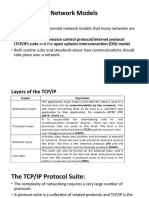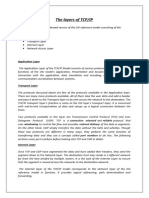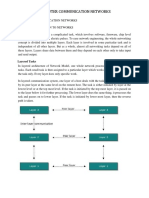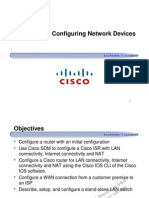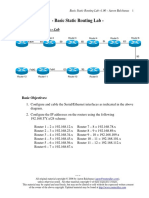0 ratings0% found this document useful (0 votes)
7 viewsOsi Model
Osi Model
Uploaded by
aneezashahid3469notes
Copyright:
© All Rights Reserved
Available Formats
Download as PDF, TXT or read online from Scribd
Osi Model
Osi Model
Uploaded by
aneezashahid34690 ratings0% found this document useful (0 votes)
7 views20 pagesnotes
Original Title
osi model-
Copyright
© © All Rights Reserved
Available Formats
PDF, TXT or read online from Scribd
Share this document
Did you find this document useful?
Is this content inappropriate?
notes
Copyright:
© All Rights Reserved
Available Formats
Download as PDF, TXT or read online from Scribd
Download as pdf or txt
0 ratings0% found this document useful (0 votes)
7 views20 pagesOsi Model
Osi Model
Uploaded by
aneezashahid3469notes
Copyright:
© All Rights Reserved
Available Formats
Download as PDF, TXT or read online from Scribd
Download as pdf or txt
You are on page 1of 20
Course Name: Computer Networks
Course Code: ICT-402
Credit Hours: 4(3-1)
Topic: (Network system Architectures (OSI
and TCP/IP models)
Level: BS
Lecture # 4
Department of Information Technology , Government College Women University Faisalabad
The OSI Model
• International Standards Organization (ISO) has
defined a model for describing communications
across a network, called the OSI model, for Open
Systems Interconnect (reference model).
• This model is a generalized abstraction of how
network communication can be and is
implemented.
• The model does not fit every network technology
perfectly, but it is widely used to discuss and refer
to the layers of technology involved in networking
The OSI Model
1. Physical (Bits)
2.Data Link (Frames)
3. Network (Packets)
4. Transport (Segment)
5. Session (Dialog units)
6. Presentation (Raw Data)
7. Application (Text, Numbers)
Physical (Layer 1)
• OSI Model, Layer 1 conveys the bit stream -
electrical impulse, light or radio signal —
through the network at the electrical and
mechanical level. It provides the hardware
means of sending and receiving data on a
carrier, including defining cables, cards and
physical aspects. Fast Ethernet, RS232, and
ATM are protocols with physical layer
components.
o Data Rate / Transmission Rate
Date Rate ( Bits per second) also decided by the Physical
Layer
So , Physical layer defines the Duration of a Bit
Means how long will a bit last
o Synchronization of Bits
Sender and Receiver must be synchronized at the bit level
Sender and Receiver clocks must be synchronized
It is done by Physical layer
o Line Configuration
Physical Layer is also concerned with Line Configuration
Line Configuration represents the connection of device with
the Medium
Point-To-Point or Multipoint
Data Link (Layer 2)
• At OSI Model, Layer 2, data packets are encoded
and decoded into bits. It furnishes transmission
protocol knowledge and management and
handles errors in the physical layer, flow control
and frame synchronization. The data link layer is
divided into two sub layers: The Media Access
Control (MAC) layer and the Logical Link Control
(LLC) layer. The MAC sub layer controls how a
computer on the network gains access to the data
and permission to transmit it. The LLC layer
controls frame synchronization, flow control and
error checking
• Responsible for Node to Node Delivery
• Makes physical layer look error free to
the upper layer
• Framing
The data link divides the stream of bits
from Network layer into manageable data
units called “FRAMES”. This process is
known as Framing.
• Network (Layer 3)
• Responsible for Source-to-Destination delivery
• DL Layer oversees the delivery of data between 2
systems on the same network
• Network Layer ensures that each packet gets
from its point of origin to its final destination
• Layer 3 provides switching and routing
technologies, creating logical paths, known as
virtual circuits, for transmitting data from node to
node. Routing and forwarding are functions of this
layer, as well as addressing, internetworking, error
handling, congestion control and packet
sequencing.
Transport (Layer 4)
• OSI Model, Layer 4, Responsible for
Source-to-Destination delivery of Entire
Message
• It provides transparent transfer of data
between end systems, or hosts, and is
responsible for end-to-end error recovery and
flow control. It ensures complete data
transfer.
• Session (Layer 5)
• This layer establishes, manages and terminates
connections between applications. The session layer
sets up, coordinates, and terminates conversations,
exchanges, and dialogues between the applications at
each end. It deals with session and connection
coordination.
• Presentation (Layer 6)
• This layer provides independence from differences in
data representation (e.g., encryption) by translating
from application to network format, and vice versa.
The presentation layer works to transform data into
the form that the application layer can accept. This
layer formats and encrypts data to be sent across a
network, providing freedom from compatibility
problems. It is sometimes called the syntax layer.
• Application (Layer 7)
• OSI Model, Layer 7, supports application and
end-user processes. Communication partners are
identified, quality of service is identified, user
authentication and privacy are considered, and
any constraints on data syntax are identified.
Everything at this layer is application-specific. This
layer provides application services for file
transfers, e-mail, and other network software
services. Telnet and FTP are applications that exist
entirely in the application level. Tiered application
architectures are part of this layer.
TCP/IP PROTOCOL
TCP/IP
• TCP/IP, or the Transmission Control
Protocol/Internet Protocol, is a suite of
communication protocols used to
interconnect network devices on the internet.
TCP/IP can also be used as a communications
protocol in a private network (an intranet or
an extranet).
• The entire internet protocol suite a set of rules
and procedures is commonly referred to as
TCP/IP, though others are included in the suite.
• TCP/IP specifies how data is exchanged
over the internet by providing end-to-end
communications that identify how it
should be broken into packets,
addressed, transmitted, routed and
received at the destination. TCP/IP
requires little central management, and it
is designed to make networks reliable,
with the ability to recover automatically
from the failure of any device on the
network.
• The two main protocols in the internet
protocol suite serve specific
functions. TCP defines how applications can
create channels of communication across a
network. It also manages how a message is
assembled into smaller packets before they
are then transmitted over the internet and
reassembled in the right order at the
destination address.
• IP defines how to address and route each
packet to make sure it reaches the right
destination. Each gateway computer on the
network checks this IP address to determine
where to forward the message
How TCP/IP works
• TCP/IP uses the client/server model of communication in
which a user or machine (a client) is provided a service (like
sending a webpage) by another computer (a server) in the
network.
• Collectively, the TCP/IP suite of protocols is classified
as stateless, which means each client request is considered
new because it is unrelated to previous requests. Being
stateless frees up network paths so they can be used
continuously.
• The transport layer itself, however, is stateful. It transmits a
single message, and its connection remains in place until all
the packets in a message have been received and
reassembled at the destination.
TCP/IP model layers
• TCP/IP functionality is divided into four layers,
each of which include specific protocols.
• The application layer provides applications with
standardized data exchange. Its protocols include
the Hypertext Transfer Protocol (HTTP), File
Transfer Protocol (FTP), Post Office Protocol 3
(POP3), Simple Mail Transfer Protocol (SMTP) and
Simple Network Management Protocol (SNMP).
• The transport layer is responsible for maintaining
end-to-end communications across the network.
TCP handles communications between hosts and
provides flow control, multiplexing and reliability.
• The network layer, also called the internet
layer, deals with packets and connects
independent networks to transport the
packets across network boundaries. The
network layer protocols are the IP and
the Internet Control Message Protocol
(ICMP), which is used for error reporting.
• The physical layer consists of protocols
that operate only on a link -- the network
component that interconnects nodes or
hosts in the network. The protocols in this
layer include Ethernet for local area
Advantages of TCP/IP
• TCP/IP is nonproprietary and, as a result, is
not controlled by any single company.
Therefore, the internet protocol suite can be
modified easily. It is compatible with all
operating systems, so it can communicate
with any other system. The internet protocol
suite is also compatible with all types of
computer hardware and networks.
You might also like
- Wireshark TCP v8.1Document13 pagesWireshark TCP v8.1k34945678No ratings yet
- Lab 5-1 - Basic Manual Phone Configuration Using The CLI - Packet TracerDocument12 pagesLab 5-1 - Basic Manual Phone Configuration Using The CLI - Packet TracerMubba AhmedNo ratings yet
- MA5800 Padrao Configuracao SRL MA5800V100R019C12SPH203.v3Document15 pagesMA5800 Padrao Configuracao SRL MA5800V100R019C12SPH203.v3Romero Costa0% (1)
- CCNA 2 v7 Modules 1 - 4 - Switching Concepts, VLANs, and InterVLAN Routing Exam AnswersDocument37 pagesCCNA 2 v7 Modules 1 - 4 - Switching Concepts, VLANs, and InterVLAN Routing Exam AnswersBrali Dioulson Nguema0% (1)
- Computer Networks 159.334 Answers Tutorial No. 5 Professor Richard HarrisDocument3 pagesComputer Networks 159.334 Answers Tutorial No. 5 Professor Richard HarrisMinh QuangNo ratings yet
- CCN Note First Module - CompressedDocument21 pagesCCN Note First Module - CompressedsbaleemaNo ratings yet
- Data Communication & NetworkingDocument71 pagesData Communication & NetworkingShabanaNo ratings yet
- Network Protocol and TCPDocument5 pagesNetwork Protocol and TCPJoshua SantillanaNo ratings yet
- Communications Layers SummaryDocument7 pagesCommunications Layers SummaryKarthickmanikandan GNo ratings yet
- CN ImpDocument32 pagesCN Impblkhackr1jNo ratings yet
- Fundamental Network ModelsDocument9 pagesFundamental Network ModelsSailas Khulumani TshabanguNo ratings yet
- PDF DocumentDocument5 pagesPDF DocumentBritney PitttersonNo ratings yet
- NetworkingDocument19 pagesNetworkingHansika MannapperumaNo ratings yet
- The OSI and TCPDocument8 pagesThe OSI and TCPSreejith VaneryNo ratings yet
- Winter Semester 2023-24 - CSE3003 - ETH - AP2023246000860 - 2024-01-19 - Reference-Material-IDocument42 pagesWinter Semester 2023-24 - CSE3003 - ETH - AP2023246000860 - 2024-01-19 - Reference-Material-IVinit mehraNo ratings yet
- Tcp/Ip Protocol SuiteDocument17 pagesTcp/Ip Protocol Suitemadhavi gulhaneNo ratings yet
- Network Protocol ArchitecturesDocument17 pagesNetwork Protocol Architecturesamash.emillyNo ratings yet
- A Brief Summary On TCP/IPDocument30 pagesA Brief Summary On TCP/IPShubham VishwakarmaNo ratings yet
- 98-366 MVA Slides Lesson 2Document29 pages98-366 MVA Slides Lesson 2cvigaNo ratings yet
- Lecture 2Document8 pagesLecture 2jasmhmyd205No ratings yet
- Lecture 1Document7 pagesLecture 1owronrawan74No ratings yet
- CN 1Document7 pagesCN 1T024KOUSTAV CHATTERJEENo ratings yet
- Chapter 4-7@networking ModelsDocument94 pagesChapter 4-7@networking ModelsSilabat AshagrieNo ratings yet
- 1.0 The OSI (Open Systems Interconnection) ModelDocument5 pages1.0 The OSI (Open Systems Interconnection) Modelvickypatel_63873791100% (1)
- Chapter Four - Part ThreeDocument17 pagesChapter Four - Part ThreederejbuzuNo ratings yet
- TCP CharacteristicsDocument38 pagesTCP CharacteristicsgidumafayeraNo ratings yet
- NetworkDocument82 pagesNetworkDavidoffNo ratings yet
- TCP:IP Reference ModelDocument12 pagesTCP:IP Reference Modelsocekay372No ratings yet
- OSI and TCP IP MODELDocument29 pagesOSI and TCP IP MODELHarsh IsamaliaNo ratings yet
- Osimodel 170406162300 PDFDocument42 pagesOsimodel 170406162300 PDFPvkkiy EceNo ratings yet
- Network Interface LayerDocument3 pagesNetwork Interface LayerdhasalswapnilNo ratings yet
- Network Protocols - TutorialspointDocument5 pagesNetwork Protocols - TutorialspointThusharika ThilakaratneNo ratings yet
- Defining Networks With The OSI ModelDocument29 pagesDefining Networks With The OSI ModelPradeep ManralNo ratings yet
- Chapter 02 Network ModelsDocument21 pagesChapter 02 Network ModelsFarhan TamzidNo ratings yet
- NetworkingDocument3 pagesNetworkingKshitij PanditNo ratings yet
- Unit 3 - It121Document35 pagesUnit 3 - It121levisqueen26No ratings yet
- Ta 104 TCPDocument14 pagesTa 104 TCPLovepreet SinghNo ratings yet
- Week 3Document5 pagesWeek 3hiren_keepsmilingNo ratings yet
- Computer Networking Refers To Connected Computing Devices 222Document13 pagesComputer Networking Refers To Connected Computing Devices 222RAY COOLNo ratings yet
- Week2-Application Layer FixDocument38 pagesWeek2-Application Layer FixBaekhyuneeNo ratings yet
- 19-203-0802 Computer Commu-Nication and Net - Working: Professional Elective - IV SEM-8Document45 pages19-203-0802 Computer Commu-Nication and Net - Working: Professional Elective - IV SEM-8Ťèjùźź ȚèjùNo ratings yet
- DCCN Notes Unit1Document61 pagesDCCN Notes Unit1pratheepku32No ratings yet
- Networking 2: It 219: Lesson IvDocument19 pagesNetworking 2: It 219: Lesson IvKlim Hazel Racal LumansocNo ratings yet
- "Please Do Not Throw Sausage Pizza Away": Layer 7: Application LayerDocument3 pages"Please Do Not Throw Sausage Pizza Away": Layer 7: Application LayerAndres GonzalezNo ratings yet
- The TCPDocument4 pagesThe TCPSYAMANTA GARUDNo ratings yet
- Lecture 5Document10 pagesLecture 5AyushNo ratings yet
- OSI Model & Tcp/Ip ProtocolDocument31 pagesOSI Model & Tcp/Ip ProtocolSauabh SrivastavaNo ratings yet
- CN Unit 5Document20 pagesCN Unit 5chatkall46No ratings yet
- The Layers of TCPDocument2 pagesThe Layers of TCPNaveen RecizNo ratings yet
- # TCP/IP Protocol Layers:-1.application Layer: Protocols UsedDocument8 pages# TCP/IP Protocol Layers:-1.application Layer: Protocols UsedPRIYANSHU KUMARNo ratings yet
- Ref ModelDocument19 pagesRef Modelkalpana.gangwarNo ratings yet
- 10ec71 - CCN - Notes PDFDocument127 pages10ec71 - CCN - Notes PDFRashmi Samant100% (2)
- Lab ManualDocument126 pagesLab ManualEnduku MeekuNo ratings yet
- Ministry of Water Resources and ElectricityDocument26 pagesMinistry of Water Resources and ElectricitymeshelNo ratings yet
- Computer Networks Set 2Document19 pagesComputer Networks Set 2madhavibandari609No ratings yet
- CN Unit2Document6 pagesCN Unit2OmNo ratings yet
- CN Book 2017-3-11Document9 pagesCN Book 2017-3-11mspriyarcNo ratings yet
- NetworkDocument67 pagesNetworkBiplov SapkotaNo ratings yet
- Network ProtocolDocument5 pagesNetwork ProtocolNayana SurendranNo ratings yet
- Chapter 4 - Internetworking-1Document91 pagesChapter 4 - Internetworking-1Goitom HaileNo ratings yet
- Network Support Group (Rajasthan)Document177 pagesNetwork Support Group (Rajasthan)Pankaj Barala100% (1)
- Work Protocols and ArchitecturesDocument51 pagesWork Protocols and ArchitecturesSaleih GeroNo ratings yet
- OSIModelDocument9 pagesOSIModelMukeshNo ratings yet
- Chapter 2 Communicating Over The NetworkDocument34 pagesChapter 2 Communicating Over The Networkelaine grace lariosaNo ratings yet
- Hacking Network Protocols: Unlocking the Secrets of Network Protocol AnalysisFrom EverandHacking Network Protocols: Unlocking the Secrets of Network Protocol AnalysisNo ratings yet
- Misc Topics in Computer NetworksDocument160 pagesMisc Topics in Computer NetworksmagisrajNo ratings yet
- Project Report On Dns Forensics: Submitted in Fulfillment For The Award ofDocument42 pagesProject Report On Dns Forensics: Submitted in Fulfillment For The Award ofSuman Kumar SonuNo ratings yet
- CNDocument7 pagesCNVivek Vikram SinghNo ratings yet
- CCNA Dis2 - Chapter 5 - Configuring Network Devices - PPT (Compatibility Mode)Document150 pagesCCNA Dis2 - Chapter 5 - Configuring Network Devices - PPT (Compatibility Mode)http://heiserz.com/No ratings yet
- UNV TIC6831ER-F50-4X38P 4MP Dual-Spectrum Starlight Intelligent PTZ Dome Camera V1.0Document5 pagesUNV TIC6831ER-F50-4X38P 4MP Dual-Spectrum Starlight Intelligent PTZ Dome Camera V1.0Puthuyaveetil SoorajNo ratings yet
- CCN Assignment 4Document5 pagesCCN Assignment 4VishnuVardhan ReddyNo ratings yet
- CSSE280: Introduction To Web Programming: Introductions, Internet, WWW, HTML IntroDocument30 pagesCSSE280: Introduction To Web Programming: Introductions, Internet, WWW, HTML IntroGamal BohoutaNo ratings yet
- Techinical Interview Questions I: Good Evening SirDocument3 pagesTechinical Interview Questions I: Good Evening SirmosesaluriNo ratings yet
- Yasser Auda CCIEv5 Unprotected GRE Tunnel, Protected GRE Tunnel With IPsec - VTIDocument7 pagesYasser Auda CCIEv5 Unprotected GRE Tunnel, Protected GRE Tunnel With IPsec - VTIMd. Rashedul AlamNo ratings yet
- Load Balancing NTHDocument2 pagesLoad Balancing NTHataNo ratings yet
- ch18-SLIDE - (2) Data Communications and Networking by Behrouz A.ForouzanDocument38 pagesch18-SLIDE - (2) Data Communications and Networking by Behrouz A.ForouzanXP2009100% (3)
- Static Basic Lab PDFDocument5 pagesStatic Basic Lab PDFKazi BarakatNo ratings yet
- Design and Implementation of Parallel To Serial Data Transmission Using Aurora Protocol For High Speed Serial Data Transmission On Virtex 5 FpgaDocument16 pagesDesign and Implementation of Parallel To Serial Data Transmission Using Aurora Protocol For High Speed Serial Data Transmission On Virtex 5 FpgaRamesh DaravathNo ratings yet
- Next Generation NetworksDocument38 pagesNext Generation NetworksAymen Ben zinebNo ratings yet
- CCNA Security v2 Chapter - 3Document6 pagesCCNA Security v2 Chapter - 3Frikisito80No ratings yet
- SOL PROJECT REPORT 15062021 083527pmDocument11 pagesSOL PROJECT REPORT 15062021 083527pmEiman WahabNo ratings yet
- Errors Reported in Alert - Log of PRODUCTION On April 7thDocument2 pagesErrors Reported in Alert - Log of PRODUCTION On April 7thniaamNo ratings yet
- Packet Through The Linux Network StackDocument32 pagesPacket Through The Linux Network StackRAMUNo ratings yet
- How To Take A Network Trace On HP-UXDocument4 pagesHow To Take A Network Trace On HP-UXAnonymous Ie0oEXP2eNo ratings yet
- Ccna TestDocument30 pagesCcna TestHoang Minh LamNo ratings yet
- Cis 185 CCNP Route Ch. 4 Manipulating Routing Updates Part 1 - Route RedistributionDocument75 pagesCis 185 CCNP Route Ch. 4 Manipulating Routing Updates Part 1 - Route RedistributionChung CongNo ratings yet
- Sonet/Sdh: Yaakov (J) Stein Chief Scientist RAD Data CommunicationsDocument110 pagesSonet/Sdh: Yaakov (J) Stein Chief Scientist RAD Data CommunicationsRk ManjunathNo ratings yet
- FffaDocument12 pagesFffaSouyama DebnathNo ratings yet
- CL Adv IPV6 SecDocument85 pagesCL Adv IPV6 Secamushtaq_14No ratings yet
- Data Link Layer: Unit - IIIDocument24 pagesData Link Layer: Unit - IIIFrancis Densil RajNo ratings yet










